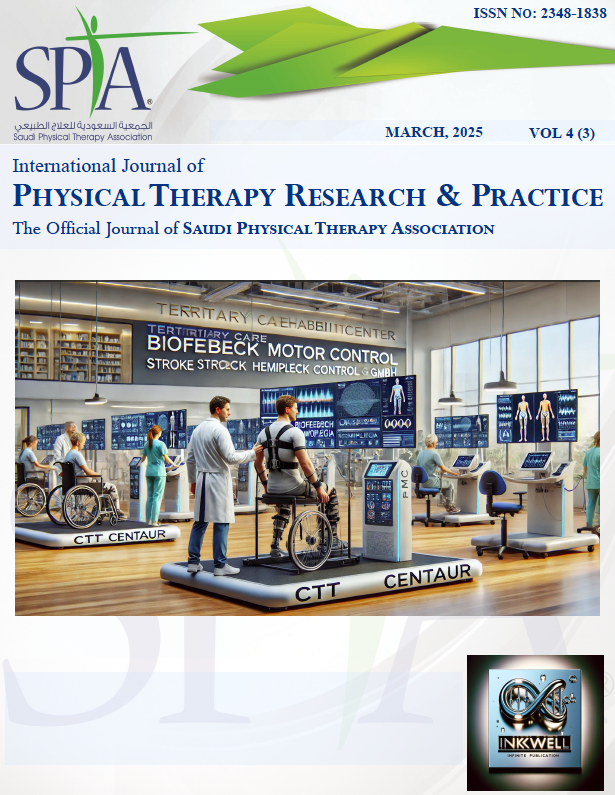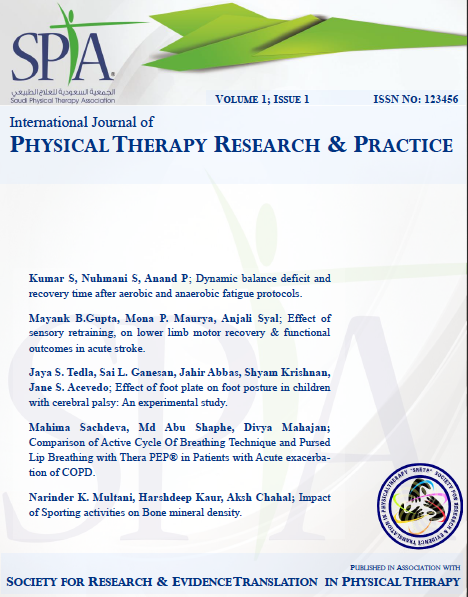Assessing Flat Foot Prevalence and Associated Risk Factors in Jazan Region: Demographic and Lifestyle Considerations
DOI:
https://doi.org/10.62464/ijoprp.v4i3.86Keywords:
Flatfoot, Prevalence, Risk Factors, BMIAbstract
Objective: The primary goal of this research was to determine the prevalence of flatfoot among adult residents of the Jazan region in Saudi Arabia. Additionally, the study sought to identify significant risk factors associated with flatfoot by analyzing demographic variables, clinical conditions, and lifestyle characteristics. Methods: This study employed a descriptive observational approach, enrolling 317 adults aged between 18 and 60 years residing in Jazan, Saudi Arabia. A self-administered online questionnaire was used to collect data, yielding 210 valid responses suitable for analysis. The questionnaire was specifically designed to capture information related to the prevalence of flatfoot, associated symptoms, and various potential risk factors, including demographic data, clinical history, lifestyle behaviors, and footwear choices. Data analysis was conducted using Microsoft Excel, with statistical measures used to establish associations between flatfoot prevalence and the evaluated variables. Results: The findings revealed that the overall prevalence of flatfoot differed significantly by gender, with females displaying a higher prevalence rate (8%) compared to males (3%). Key risk factors identified included elevated body mass index (BMI), with higher prevalence observed among individuals classified as overweight or obese—specifically, 12% of females and 5% of males in these categories were affected by flatfoot. Additionally, lifestyle factors, particularly the use of unsupportive or improper footwear, were strongly linked to increased flatfoot risk. Clinical comorbidities, notably diabetes mellitus and rheumatoid arthritis, also emerged as significant risk factors associated with flatfoot in the studied population. Conclusion: The prevalence of flatfoot in Jazan underscores the need for targeted interventions that focus on modifiable risk factors, including weight management and proper footwear. Public health initiatives should prioritize awareness and prevention strategies to mitigate flatfoot-related complications.
References
Aenumulapalli, A., Kulkarni, M., & Gandotra, A. (2017). Prevalence of Flexible Flat Foot in Adults: A Cross-sectional Study. In JOURNAL OF CLINICAL AND DIAGNOSTIC RESEARCH. JCDR Research and Publications Private Limited. https://doi.org/10.7860/jcdr/2017/26566.10059
Ahmad, T., Shafi, P. M., Khan, R., Khokhar, A. N. G. A., & Zeb, S. A. (2022). Assessing Plantar Pressure and Feet Pain in Females during the Third Trimester of Pregnancy. Pakistan Journal of Medical and Health Sciences, 16(3), 1114–1116. https://doi.org/10.53350/pjmhs221631114
Alahmari, K. A., Kakaraparthi, V. N., Reddy, R. S., Samuel, P. S., Tedla, J. S., Rengaramanujam, K., Ahmad, I., Sangadala, D. R., & Mukherjee, D. (2021). Foot Posture Index Reference Values among Young Adults in Saudi Arabia and Their Association with Anthropometric Determinants, Balance, Functional Mobility, and Hypermobility. In BioMed Research International (Vol. 2021, p. 1). Hindawi Publishing Corporation. https://doi.org/10.1155/2021/8844356
Alzahrani, A., Felix, H. C., & Al-Etesh, N. S. (2023). Determinants of periodic health examination uptake among adults in Al-Jouf Region, Saudi Arabia. In Journal of Family and Community Medicine (Vol. 30, Issue 3, p. 197). Medknow. https://doi.org/10.4103/jfcm.jfcm_63_23
Arachchige, S. N. K. K., Chander, H., & Knight, A. C. (2019). Flatfeet: Biomechanical implications, assessment and management [Review of Flatfeet: Biomechanical implications, assessment and management]. The Foot, 38, 81. Elsevier BV. https://doi.org/10.1016/j.foot.2019.02.004
Bourgleh, S. M., Nemeş, R., Hetaimish, B., & Chiuțu, L. C. (2019). Prevalence of musculoskeletal normal variations of the lower limbs in pediatric orthopedic clinic. In Saudi Medical Journal (Vol. 40, Issue 9, p. 930). Ministry of Defence and Aviation. https://doi.org/10.15537/smj.2019.9.24478
Ebrahim Sadeghi-Demneh, Isfahan University of Medical Sciences, Isfahan, Iran, Jonathan M A Melvin, Biomechanics Research Group, University of Nottingham, Nottingham, UK, Karen Mickle, Victoria University, Melbourne, Australia. (2023). Prevalence of pathological flatfoot in school-age children. https://www.sciencedirect.com/science/article/pii/S0958259217301712
Erol, K., Karahan, A. Y., Kerimoğlu, Ü., Ordahan, B., Tekin, L., Şahin, M., & Kaydok, E. (2015). An Important Cause of Pes Planus: The Posterior Tibial Tendon Dysfunction. In Clinics and Practice (Vol. 5, Issue 1, p. 699). PAGEPress (Italy). https://doi.org/10.4081/cp.2015.699
Ezema, C. I., Abaraogu, U. O., & Okafor, G. (2013). Flat foot and associated factors among primary school children: A cross-sectional study. In Hong Kong Physiotherapy Journal (Vol. 32, Issue 1, p. 13). World Scientific. https://doi.org/10.1016/j.hkpj.2013.05.001
Gupta, V. P., Ezhilarasan Santhi, S. S., Ravi, S., & Ramanan, E. A. (2022). Rheumatological and Musculoskeletal Complications in Diabetes Patients. Journal of Endocrinology and Metabolism, 12(4–5), 117–124. https://doi.org/10.14740/jem811
Khan, F., Chevidikunnan, M. F., Alsobhi, M., Ahmed, I. A. I., Al-lehidan, N. S., Rehan, M., Alalawi, H. A., & Abduljabbar, A. H. (2022). Diagnostic Accuracy of Various Radiological Measurements in the Evaluation and Differentiation of Flatfoot: A Cross-Sectional Study. In Diagnostics (Vol. 12, Issue 10, p. 2288). Multidisciplinary Digital Publishing Institute. https://doi.org/10.3390/diagnostics12102288
Pourghasem, M., Kamali, N., Farsi, M. M., & Soltanpour, N. (2016). Prevalence of flatfoot among school students and its relationship with BMI. In Acta Orthopaedica et Traumatologica Turcica (Vol. 50, Issue 5, p. 554). Elsevier BV. https://doi.org/10.1016/j.aott.2016.03.002
Putri, N. S. A., Arfianti, L., Desnantyo, A. T., & Wardhani, I. L. (2024). Flat Foot based on Clarke’s Angle Method and Overweight among Medical Students of Universitas Airlangga. Juxta: Jurnal Ilmiah Mahasiswa Kedokteran Universtas Airlangga, 15(2), 113–118. https://doi.org/10.20473/juxta.v15i22024.113-118
Salinas-Torres, V. M., Salinas-Torres, R. A., Carranza-García, L. E., & Tristán-Rodríguez, J. L. (2023). Prevalence and clinical factors associated with pes planus among children and adults: A population-based synthesis and systematic review. Journal of Foot & Ankle Surgery. https://doi.org/10.1053/j.jfas.2023.05.007
Van Boerum, D. H., Sangeorzan, B. J., & Sangeorzan, B. J. (2003). Biomechanics and pathophysiology of flat foot. Foot and Ankle Clinics of North America, 8(3), 419–430. https://doi.org/10.1016/S1083-7515(03)00084-6
Witari, N. P. D., Cahyawati, P. N., & Lestarini, A. (2018). Prevalence faltfoot in primary school. In IOP Conference Series Materials Science and Engineering (Vol. 434, p. 12029). IOP Publishing. https://doi.org/10.1088/1757-899x/434/1/012029.

Downloads
Published
Issue
Section
License
Copyright (c) 2025 International Journal of Physical Therapy Research & Practice

This work is licensed under a Creative Commons Attribution-NonCommercial-NoDerivatives 4.0 International License.



